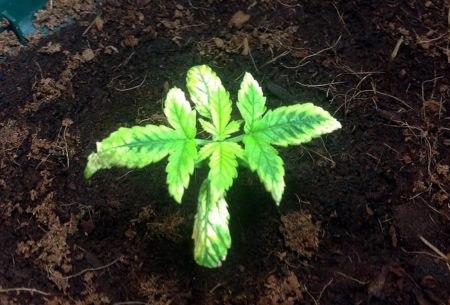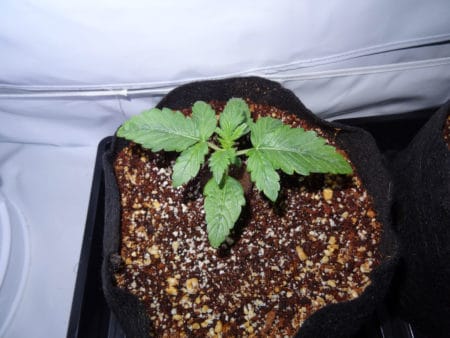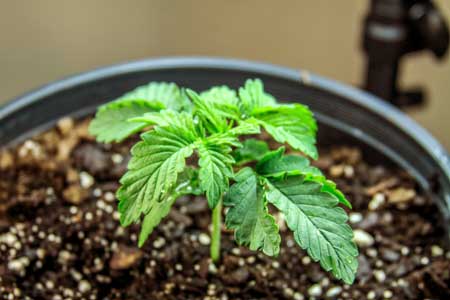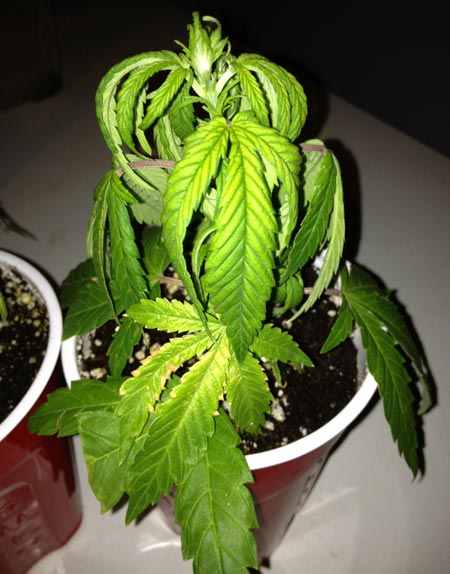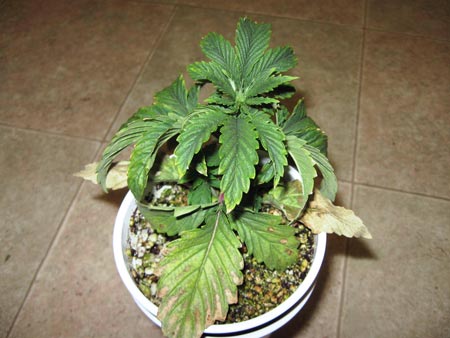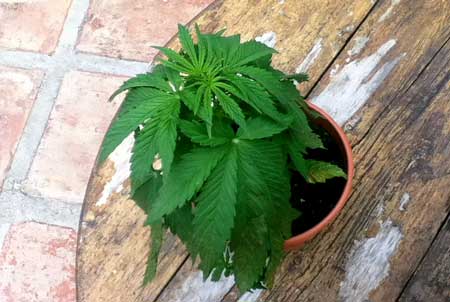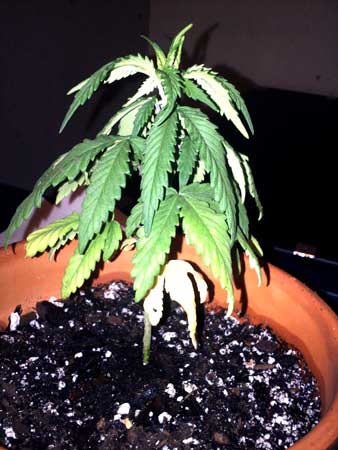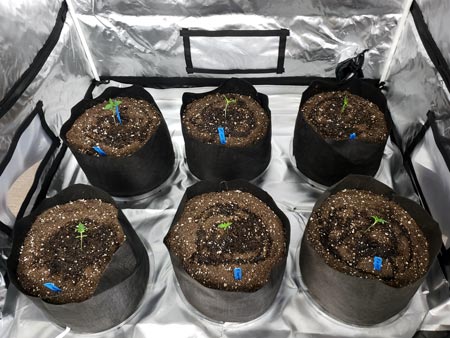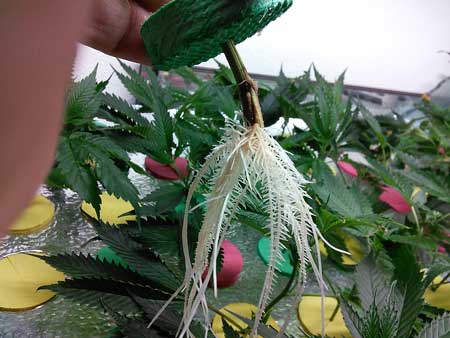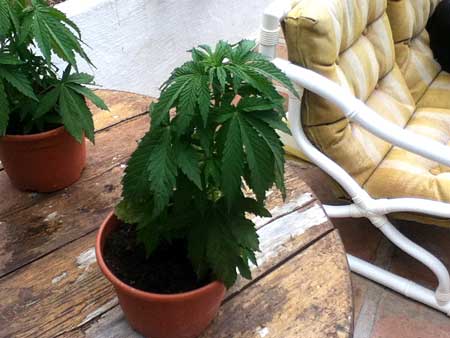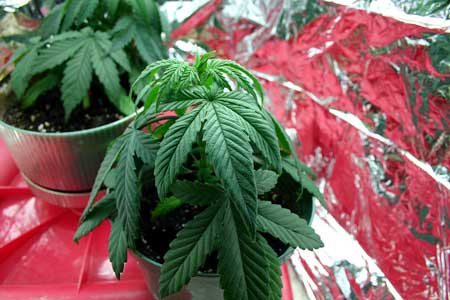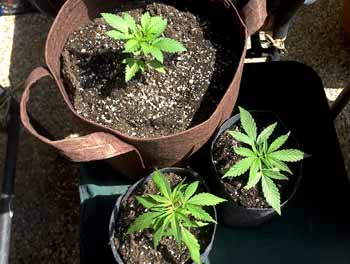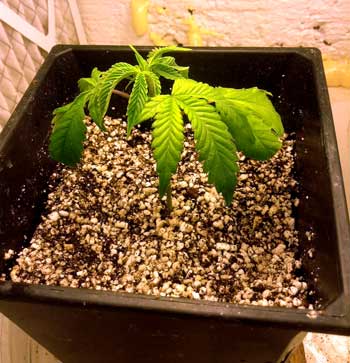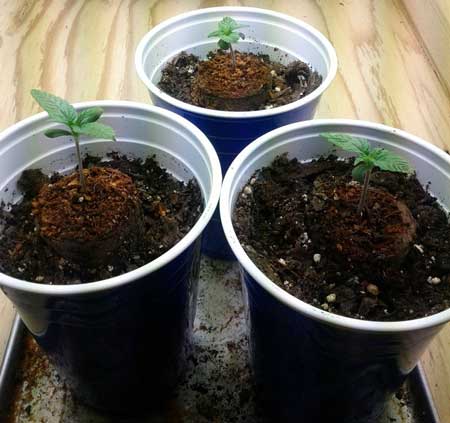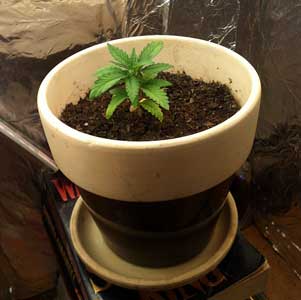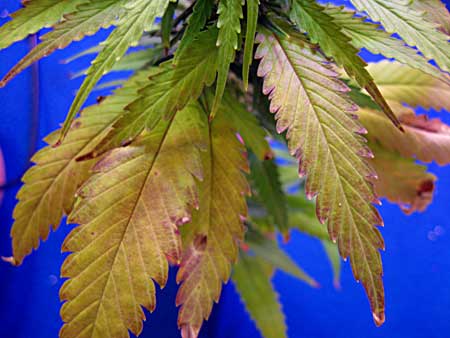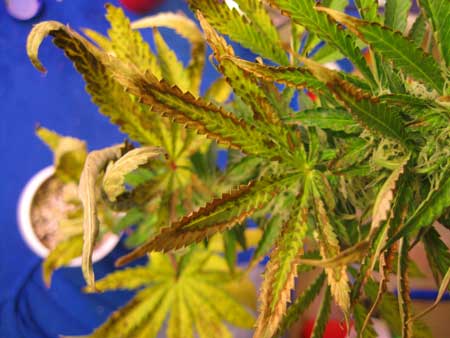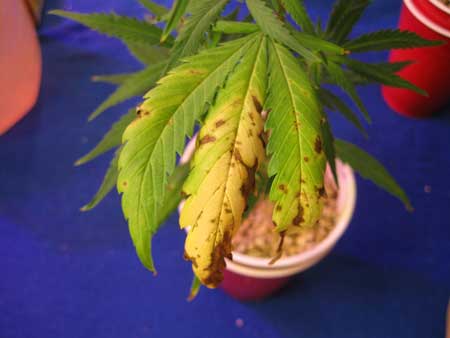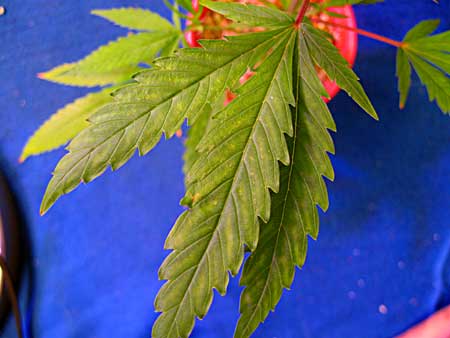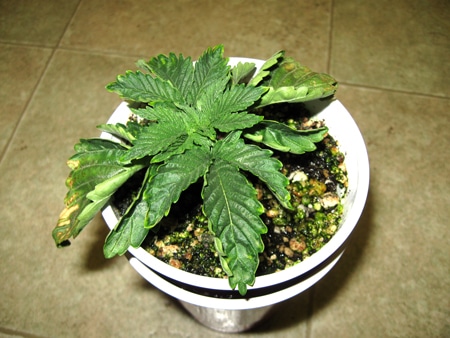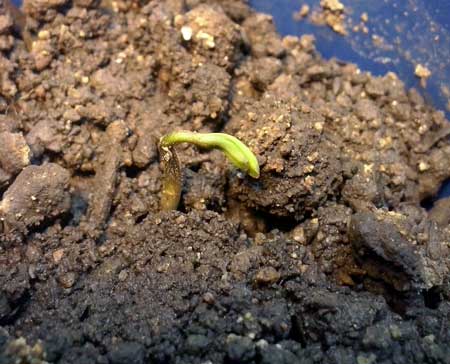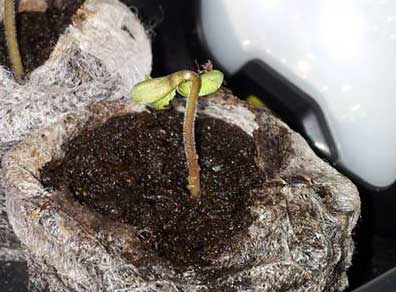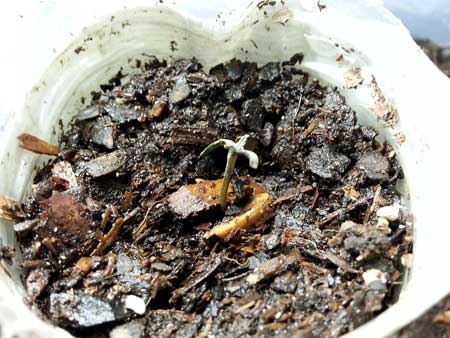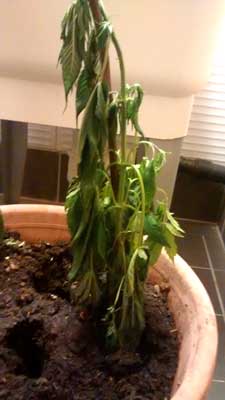by Nebula Haze
Overwatering is one of the most common cannabis seedling problems. I 100% get it. You want to give your new seedlings all the love you can. To be honest, I still do it myself sometimes. Luckily, it’s usually not a big deal and easy to fix. If your seedlings are droopy and possibly also with unexpected nutrient deficiencies, you’ve come to the right tutorial. Solution incoming.
This tutorial will teach you how to spot and treat overwatered marijuana seedlings.
Is my cannabis seedling overwatered?
What are the most common symptoms for overwatered cannabis seedlings?
- Droopy
- Nutrient deficiencies
- Growing slow (or not growing)
- Soil never dries out
- Fungus gnats or green algae on the soil (signs of soil being too wet for too long)
This is a mild case of cannabis overwatering. Notice how the leaves droop down.
This marijuana seedling is a little more overwatered.
This overwatered cannabis seedling is starting to show signs of nutrient deficiencies. This is because water and nutrients aren’t able to move properly from the roots to the leaves.
Overwatering symptoms can get out of control if you don’t do something about it. When you see green algae growing on top of the soil, that’s another sign you are overwatering your cannabis seedling (algae appears when the topsoil stays wet for too long).
Now that you have an idea of what an overwatered marijuana seedling looks like, time to get the solution.
5 most common causes of cannabis seedling overwatering:
Although you can skip this section and go straight to the problems and solutions, the following information may help you understand what’s actually going on in the seedling.
When a cannabis plant is “overwatered” it has less to do with the water and more to do with oxygen. Plants can even grow directly in water (hydroponics) but in order to thrive, roots need oxygen. In hydroponics, that’s accomplished by dissolving oxygen into the water. But when plants are grown in a container, too much water = not enough oxygen.
When a plant’s roots are sitting in water, they quickly use up all the oxygen until the growing medium starts to dry out. Without enough oxygen at the roots, the plant will start showing symptoms of oxygen deprivation. Next, a variety of plant processes start to fail because water and nutrients aren’t able to move freely through the plant. Luckily, there are many steps you can take to prevent overwatering your cannabis plants.
While overwatering can display many different symptoms, most overwatered cannabis plants look droopy, like this…
Despite what seems like an obvious cause, several different scenarios can end in overwatering. Here are some of the most common trouble-makers:
Giving too much water at a time
This is “over watering” in its most basic form. You’re giving your seedlings too much water at a time. Tiny little roots can only drink so much and if they get waterlogged for too long you’ll start seeing symptoms of overwatering.
Notice how dark the soil is in this picture because the grower soaked the grow medium. That’s more water than a small cannabis plant can drink and as a result, it started drooping.
Solution to Overwatered Seedlings
Try to maintain a schedule that lets you water your cannabis plants every few days without them looking droopy.
- Water in a small circle around the base of a seedling when they’re small to avoid giving more water than it can use
- If your growing medium takes longer than 3 days for the top to dry, it means you’re giving too much water at once. Try giving less water at a time until the grow medium starts drying faster.
It’s recommended to water in a small circle around cannabis seedlings.
Just remember that the more often you water your plants, the less water you should give at a time (watering more often doesn’t make roots drink more). Also, keep in mind that a small container tends to dry out fast while a bigger container holds onto the water for longer.
While oxygen is available to the roots immediately after watering, the roots use up all the oxygen quickly if they are sitting in water. If all the oxygen is gone, roots are not able to get what they need to help power growth, at least not until the growing medium begins to dry out and create new air spaces in the growing medium.
Keep roots happy for fast-growing cannabis plants.
Each air spot in the potting mix provides roots with precious oxygen, but if there are no air spots, roots start to “drown.” By watering seedlings less often, growers can ensure that roots are getting access to plenty of oxygen at all times.
Of course, you should never allow roots to actually dry out. Roots need moisture at all times. But for new growers who want to do everything possible for their new seedlings, it can seem like more water = better. Unfortunately, this isn’t true.
Roots work best when they get as much oxygen as possible while also staying completely moist at all times.
How to Fix:
- Wait until the top inch is dry. Make sure that the top bit of potting mix has started to dry before you water the seedlings again. Sometimes it can take a few days, depending on your growing medium, your environment, and how much water you provided during the last watering. Plants grown in coco tend to be more tolerant to lots of water and the top doesn’t need to fully dry out, but plants grown in soil are extra susceptible to overwatering. That means if you suspect you have an overwatering problem and plants are in the soil, you should allow the entire top to dry between waterings.
- Increase the number of air pockets in the growing medium (next grow, or if you decide to transplant this seedling) by mixing in a “lighter” amendment like perlite to the potting mix. Perlite will allow the mix to hold onto more oxygen when mixed with heavy soil. Many cannabis growers will mix 30% perlite into their potting mix to make sure there’s lots of drainage and plenty of air available for the roots.
- Provide air from the sides. Transplant to a container that allows air in from the sides like fabric pots (“Smart Pots” – highly recommended) or air pots. Learn more about smart pots and air pots.
- Start in a smaller container next time so there’s less water in the potting mix that needs to dry. You’ll be able to water your plants more often while ensuring they get plenty of oxygen.
- Water less when it’s cold. Plant processes tend to slow down when temps get cooler. This means that plants usually need water less often than normal after a cold snap.
This cannabis plant went through a few cool days but the grower continued to water as normal. As a result, the plant’s roots were surrounded by too much water and the plant started showing signs of overwatering.
This cannabis plant was watered the right amount each time, but too often. As a result, it shows some slight drooping. While this won’t kill the plant, the plant will definitely grow faster when the mix is allowed to dry out a bit so the roots are getting plenty of oxygen.
Pot is Too Big (Big Pot, Small Seedling)
When you have a small plant in a very big pot, it’s easy to overwater because the roots aren’t drinking much yet, and the big container takes a long time to dry out.
Notice how the cannabis plants in smaller containers have grown more than the plant that was put in a big container as a seedling. It’s common for plants in too-big containers to grow a little slowly at first.
How to fix:
- (Recommended) Start seedlings in a smaller container until they’re growing vigorously, then transfer to a larger container
- If the seedling is already in a big container, there’s still hope. When watering, give just a little water at a time in a small circle around the seedling. Then allow the top inch of your medium to mostly dry before watering again. Once the plant is growing vigorously, start watering as normal (with extra runoff water coming out the bottom every time)
This small cannabis plant was put in a big pot and given enough water to support a much larger plant. The plant couldn’t drink all the water and its roots weren’t able to get the oxygen they needed. As a result, the plant started “drowning.” Once the roots are out of commission, the leaves start drooping.
One way to prevent this from happening is to make sure your plants are in an appropriately sized container for each stage of their life; this is done with transplanting.
First, you need to get a general idea of the final container size which will be based on how big you want your plants to grow. The less often you transplant, the bigger the final size pot you’ll need because the roots will tend to grow out and cover the whole container if left too long. You can help avoid problems with roots getting rootbound by using a fabric pot (also known as a “Smart Pot”) or an air pot.
Final Container for Desired Plant Size – General guide
(the less often you transplant your plants, the bigger final size you’ll need)
12″ ~ 2-3 gallon container
24″ ~ 3-5 gallon container
36″ ~ 5-7 gallon container
48″ ~ 6-10 gallon container
60″ ~ 8-10+ gallon container
But what size pot should you use for your seedlings?
For the fastest growth rates in the beginning, it’s better to plant young seedlings or clones in a very small container, like a disposable plastic solo cup.
For new cannabis seedlings and clones, use a small container if possible.
Why don’t you want to put your cannabis seed directly into a 5-gallon pot?
Seedlings don’t use much water. When you completely saturate a big container that slow speed means that the plant won’t be able to drink all the water. Since so much of the water is contained in the middle without access to air, it won’t be able to dry out by evaporation. This means you’re left with a huge container full of wet potting mix.
The young cannabis plant roots will quickly use up all the available oxygen that’s been dissolved in the water, and then the roots will sit in water until the water slowly evaporates on its own. Some containers such as smart pots and air pots allow air in from the sides, which can help dry the growing medium faster, but it’s better to use proper technique from the beginning.
Overpotting Cannabis
Planting in too big a container is sometimes called “overpotting.” It’s possible to get around this with special watering techniques (for example by giving plants just a little bit of water until they start “growing into” their containers) but starting plants in small containers and transplanting as needed can be a more straightforward way for some growers. Overpotting plants is also a waste of growing medium and nutrients, especially if the plants never get big enough to fully use their containers.
Example
This OG Tahoe Kush seedling was overpotted, though this can be overcome by the grower just giving a little bit of water at a time until the plant starts growing vigorously. At that point, the grower can provide more and more water until they’re finally watering normally.
Example watering schedule for seedlings in 5-gallon fabric pots for first 30 days. Your seedling may need more or less water depending on the temperature, humidity, and how strong the grow light, but many growers have asked for a simple schedule to get an idea of what they’re aiming for if they’ve got a seedling in a big pot.
- Day 1 – Give 1 cup (250ml) water per plant
- Day 3 – Give 2 cups (500ml) water per plant (wait 3 days after this one since you just upped it)
- Day 6 – Give 2 cups (500ml) water per plant
- Day 8 – Give 3 cups (750ml) water per plant (every 3 days after this)
- Day 11 – Give 3 cups (750ml) water per plant
- Day 14 – Give 4 cups (1 liter) water per plant
- Day 17 – Give 4 cups (1 liter) water per plant
- Day 20 – Give 5 cups (1.25 liter) water per plant
- Day 23 – Give 6 cups (1.5 liter) water per plant
- Day 26 – Give 6 cups (1.5 liter) water per plant
- Day 29 – Give 8 cups or 1/2 gallon (2 liter) water per plant
- Continue giving 1/2 gallon (2 liters) per plant every 3 days (more or less often as needed)
Pot is Too Small (Small Pot, Big Seedling)
While using a too-large container can cause problems for seedlings, so can too-small of a container.
Seedlings are happy in a small container like a solo cup for a while, but as they get bigger, their roots need more room. The roots tend to wrap around the outsides of the container, encasing the middle part so that water can’t get out. This is known as the plant being “root bound.”
If the seedling isn’t transferred to a bigger container in time, it can cause symptoms of overwatering, nutrient deficiencies, wilting, and sometimes very strange and unpredictable symptoms.
These plants were left in a too-small container for too long. Because they were drinking so fast, the grower watered them frequently – too frequently. This combination of being root bound and overwatering caused the plants to suffer.
A too-small container, combined with overwatering – these conditions can cause some strange symptoms that often look like a cannabis nutrient deficiency.
Pink leaves, red discoloration, rusty spots, and edges… While it may look like these cannabis seedlings are experiencing nutrient deficiencies, all these symptoms are actually caused by a combination of overwatering plus a too-small pot.
When the roots aren’t happy, the plant isn’t able to uptake nutrients properly and cannabis seedlings can show a wide variety of strange problems.
It’s usually not a good sign when cannabis leaves start “crossing their fingers” like this (instead of having all the leaf tips spread out). While this can happen naturally every once in a while, you know for sure that you’re having a problem if the crossed fingers are combined with discoloration of the leaves. Also, notice how the stems are bright red/pink.
The following cannabis plant was also overwatered and had no drainage. Notice how dark the soil is and the green algae growing all along the top of the soil – these are more signs the plant has been overwatered for quite a while. You should never water your plant when the soil on top is still wet, and if you notice lots of algae growing on top of your soil, it may be a sign that you’re overwatering on a regular basis. Leaving the top of the soil wet is also the number one reason growers get fungus gnats.
No Drainage (or poor drainage)
Cannabis roots need oxygen to thrive, and therefore they will have trouble if the roots are “drowned.” If water cannot run out the bottom of the container, it will pool at the roots, which causes overwatered plants.
How to fix:
- Always start with a good growing medium that drains well – never use a clay-based soil that holds onto way a ton of water. A high-quality potting mix (especially mixed with some perlite) provides great drainage
- Start with a smaller container to reduce the chances of overwatering seedlings
- Make sure there are plenty of drainage holes to let water out the bottom of the container
- If water runs through the growing medium slowly, you can mix perlite into the potting mix to increase oxygen and quicken drainage
- Water less often and less at a time until the plant is drinking more
- Get a container that helps the growing medium dry out from the sides (such as “Smart Pots” – highly recommended; or air pots).
- Don’t allow plants to sit in a tray that has been collecting runoff water
This cannabis seedling started “damping off” (dying) due to terrible drainage from bad soil. Never use soil that looks like it contains significant amounts of clay.
Here’s another example of a cannabis seedling damping off due to too much water (drowning roots), this time combined with not enough light. After a few days of these conditions, this seedling just fell over and started dying.
The following cannabis plant was grown in an unsuitable growing medium with no drainage and started showing signs of overwatering. Always start with a quality potting mix that has good drainage, and never allow the top of your growing medium to look this wet.
This “soil” is more like mud. The cannabis plant roots are drowning from lack of oxygen, causing severe wilting.
I hope this article helped you find both the cause and solution to your overwatered marijuana seedlings. If you feel like we missed something on this page, don’t hesitate to contact us and let us know.

